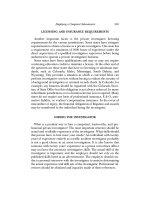Basic Private Investigation A Guide to Business Organization Management and Basic Investigative Skills for the Private Investigator pot
Bạn đang xem bản rút gọn của tài liệu. Xem và tải ngay bản đầy đủ của tài liệu tại đây (91.27 KB, 12 trang )
Employing a Competent Subcontractor 285
LICENSING AND INSURANCE REQUIREMENTS
Another important factor is the private investigator licensing
requirements for the various jurisdictions. Some states have stringent
requirements to obtain a license as a private investigator. One state has
a requirement of a minimum of 3000 hours of experience under the
direct supervision of a qualified investigative supervisor before being
authorized to operate a private investigation business.
Some states have lesser qualifications and may or may not require
continuing education credits to maintain a license. At the other end of
the spectrum are those states that have no licensing or minimum stan-
dards, such as Colorado, Idaho, Mississippi, South Dakota, and
Wyoming. This provides a situation in which a convicted felon can
perform investigative services without having to endure the scrutiny of
a background investigation or criminal records check. In Colorado, for
example, any business should be registered with the Colorado Secre -
tary of State Office but this obligation is not always enforced. In many
subordinate jurisdictions even a business license is not required. Many
states do not require any form of professional insurance, E & O, auto-
motive liability, or workers’ compensation insurance. In the event of
misconduct or injury, the financial obligations of litigation and awards
may be transferred to the individual hiring the investigator.
HIRING THE INVESTIGATOR
What is a prudent way to hire a competent, trustworthy, and pro-
fessional private investigator? The most important criterion should be
actual and verifiable experience of the investigator. What skills should
this person have to best meet your needs? An individual with twenty
years of experience entirely as a traffic accident investigator probably
is not a good choice in an arson investigation. It is also known that
someone with twenty years’ experience as a prison corrections officer
may not have the necessary investigative skills. The actual skill of the
investigator is important, and the employer should not rely on the
published skills listed in an advertisement. The employer should con-
duct a personal interview with the investigator to assist in determining
the actual experience and skill sets of the investigator. Professional ref-
erences should be obtained and inquiries made of these references.
286 Basic Private Investigation
An area often overlooked is the professional certifications of the
individual investigator. An important aspect is whether the certifica-
tion was earned or awarded without examination of abilities. PCI
®
of
the ASIS is an internationally recognized certification based on a min-
imum experience level, an initial investigative content examination,
and periodic recertification through a continuing education require-
ment. ASIS also awards a CPP
®
certification with similar qualification
in the security consulting arena. CFE awarded by the Association of
Certified Fraud Examiners is a similar certification with an emphasis
on the investigation of financial fraud. These certifications require con-
tinuing education credits.
Another criterion to be identified is the ability of the investigator to
conduct the necessary activities. Will the investigator personally per-
form your investigative requirements or will he or she be subcontract-
ed to another individual? This can create a potential problem: What
are the qualifications of the subcontractor? To comply with IRS re -
quirements to be a contractor or subcontractor, the employer or con-
tractor cannot direct the subcontractor to conduct the investigation in
a particularly defined manner. The task is given to the contractor and
the contractor determines how the task is to be accomplished.
When interviewing a potential investigator, it is prudent to deter-
mine the extent of investigative resources available to the investigator.
The question is, “What are the qualifications” of the individual from
whom the investigator may obtain investigative assistance. This is es -
pecially important if portions of the investigation will be conducted in
other states or countries.
INTERNATIONAL INVESTIGATIONS
Conducting investigations in an international environment involves
problems not normally encountered in the United States.
Among the many issues is the financial cost. It is unrealistic to
expect that international hourly rates will be similar to, or lower than,
rates within the United States. The recent decline of the dollar against
the Euro and other currencies has dramatically increased the costs of
an investigation. The current average minimum hourly rate for inter-
national investigations is in the $200 to $250 range.
Employing a Competent Subcontractor 287
Another issue is the manner in which international records are
maintained and the bureaucratic roadblocks to speedy compliance
with requests. In the United States, the vast majority of records and
documents are accessible via computer with the generation of imme-
diate results. It should be remembered that more than 90 percent of
the world works by old-fashioned investigative standards and practices
and has draconian secrecy laws for all investigations, including asset
searches and background checks. In some instances, the bureaucracy
requires that only a limited number of individuals have access to
records. This could mean an extended period of response time when
the designated person is unavailable to process the request.
Another issue in the international arena is the additional travel time
required because of the distance involved in getting to records storage
at distant locations. The poor-quality transportation system in some
countries dramatically increases the travel time required to complete
a project. In non-English-speaking countries there is also the cost and
time required for translations. The actual and incidental bureaucratic
costs of obtaining records on a timely basis must also be considered.
In some foreign venues, nonnative requests for information are not
given the same priority as requests from indigenous personnel are.
In addition, corruption can be a factor in some developing countries
and thus has to be included in any pricing arrangements. When a
client or fellow investigator is quoted a fee from an overseas provider,
the potential customer often decides to get a quote from several other
local providers in the country concerned. Fair enough. Sometimes
local providers will be in a better position to quote lower than an inter-
national provider, usually based on lower overhead but sometimes
based on issues of corruption. Transparency International ranks many
countries in the developing world much higher on the list of corrupt
countries than those in the western world. Unfortunately, that occa-
sionally trickles down into the private investigation industry. Some
local providers, although not necessarily most may discard your legal
papers in a process service and prepare a fraudulent affidavit of ser-
vice, or they may engage in “ghost writing” negative results, never
having conducted the required leads in the first place; taking your
money for a little literary effort.
How to minimize the costs and time delay for completion of inter-
national requests is contingent on the preparatory actions of the re -
288 Basic Private Investigation
questing investigator. It is incumbent upon the requestor to advise the
client of the difficulties encountered in international jurisdictions. Of
primary consideration should be the explanation that foreign privacy
and secrecy laws are considerably more restrictive than United States
laws. Records that are commonly available in the United States may
not be available in other countries. Secondarily, the client needs to be
advised that it normally requires additional time to complete an inter-
national investigation because of the unique political and judicial situ-
ation in each country.
There are certain steps that the requesting investigator can accom-
plish to facilitate the investigation.
1. Consider the international investigator as an integral part of your
investigative team by taking the investigator into your complete
confidence and providing all pertinent details surrounding your
client’s request. This could require that the requesting investiga-
tor to obtain the client’s consent and having the international
investigator execute a nondisclosure or noncompete agreement, if
necessary.
2. The approach to information disclosure should be to “tell every-
thing, as if you were handing over the case to a new investigator.”
This approach allows the international investigator who is unique-
ly acquainted with the local culture and bureaucratic structure to
analyze the request and prepare an investigative plan in accor-
dance with the laws of the foreign area. It is essential to solicit
advice from the international investigator who may be able to
provide direction to an area not known to the requestor.
3. The agreement with the client should document the explanation
of problems encountered in other countries, such as record-keep-
ing systems, translation problems, and travel. The agreement
should also specify the approximate turnaround time, costs and
budget limits; reporting standards, in other words, need for offi-
cial documents and signed statements, and translation responsi-
bilities.
4. When considering time constraints, it is important to coordinate
with the foreign investigator to arrive at a reasonable and man-
ageable time line.
Employing a Competent Subcontractor 289
Appropriate prior planning will prevent misunderstandings and
unanticipated results.
TIMELY EMPLOYMENT OF THE INVESTIGATOR
A problem can arise for the employer and the investigator due to
the timeliness of employment of the investigator. The investigator
should be employed as soon after the incident as possible and prior to
the filing of a complaint with the court. There are basically two rea-
sons for this employment time line. First, witness perceptions may
change based on public statements of law enforcement officers during
their investigation. Fact retention may also be hindered through aging
and people’s desire to remove the offensive facts from their memory.
Secondly, many times the investigator can provide additional inves-
tigative leads or information to the employer based on the investiga-
tor’s experience. It is basically that two heads are better than one
because they see a situation from different angles.
COSTS AND FEE SCHEDULES
A major concern anytime a private investigator is retained is the
hourly cost of investigative activity. Again, there is a cliché that states
“you get what you pay for.” The more experience and expertise that
an individual has in a specific area or specialty will have an impact on
the hourly cost. The average cost for a highly qualified investigator in
the United States is $150 to $200 per hour. Mileage costs are usually
equal to the IRS allowance and other expenses are at actual costs. Per
diem lodging and meal reimbursement should be equal to the General
Services Administration allowances for the area.
The employment of a private investigator should be subject to a
written fee schedule or contract that outlines in detail the expectations
and responsibilities of each party, including fees, expenses, hourly
rates, time requirements, and report criteria as a minimum.
290 Basic Private Investigation
SUMMARY
Obtaining quality professional investigative services is vital to a suc-
cessful conclusion to your case. To obtain a proper return on your
investment in investigative services, there are several issues for con-
sideration:
1. Make sure the investigator is reputable and experienced in the
spe cifics of your inquiry.
2. Determine the scope of the inquiry and the fee schedule at the
outset.
3. Ensure that the investigator is available to testify in court, if re -
quired.
4. Ensure that the investigator has no conflict of interest in your in -
vestigation.
INDEX
291
A
Accident scenes, 202
Alarm companies, 59
ASIS International, 35, 47–48, 286
Assisted living facilities (ALF), 61–62
Associations, professional, 47–48
Association of Certified Fraud Examiners,
35, 48
Attorneys, 139–140
B
“Burned.” See Surveillance
C
Child custody. See Divorce and child
custody
China
commercial investigation
history and trends, 159
industry status/restrictions, 161
market demand/development, 160
investigations, conducting, 159–166
market needs
assets/real property investigation, 165
background investigation, 161–163
brand protection, 166
information verification, 164
insurance claims, 164–165
seeks individual investigation, 166
Clients
building a base, 27
dispute resolution, 111–112
invoicing, 31–32
Competition (business), 13
Continuing Legal Education (CLE), 85–86
Contracts
letter of agreement, 120–121
retention, 114–119
subcontractors
agreement, 122–127
letter of instruction, 128–129
Copyright, 216
Counterfeit, 216
See also Copyright; Trademarks
D
Database searches, 212–213
Debt collection, 215
Department of Justice, xii
Disputes, financial
with clients, 111–112
letter of agreement, 120–121
prevention and resolution, 111–129
retention contract, 114–119
with subcontractors, 112–113
letter of instruction, 128–129
subcontractor agreement, 122–127
Divorce and child custody, 212
“Dry cleaning.” See Surveillance
E
Ethics, 105–109
See also Professionalism
Europe
conducting investigations, 167–175
costs, 174
language issues, 173
police/authorities, 172–173
record availability/access, 168–171
292 Basic Private Investigation
sharing information, 174–175
time/turnaround, 171–172
F
Fair Credit Report Act (FCRA), 91, 97
Financial records search, 215
Fredonia Group, 14
Funeral homes, 60–61
G
Gramm-Leach-Bliley Act, 92
H
Heirs, locating, 217
I
Identification
in Japan, 218
risk management, 222–223
Insurance
errors and omissions (E&O), 22, 97
subcontractors, 285
Intellenet
expertise, xvii
former affiliation, xvii
language skills, xvii
membership, xvi–xvii
use of, xv–xviii, 284
International work
China, 159–166
complexities of, 206–209
Europe, 167–175
Japan, 210–218
See also by country
Interpreters, 133–148
See also Interviews and interrogations
Interviews and interrogations
developing questions, 142
elderly, 141
inclusion (who not to), 190–191
interpreters
choosing, 144–145
finding, 145–146
overview, 144
locations, 142–143
methodology, 135–136
minors, 141
planning, 134–135
protocol (productive), 143–144
qualifications, 45–46
recording, 140
Reid Technique, 45
Weingarten rights, 136–140
written statements
format, 147–148
obtaining, 146–147
Investigation, types of
assets/real property, 165
background
company, 161–162, 213
personal, 163, 213
civil, 179–181
commercial, 159–161
due diligence
civil/credit/bankruptcy checks,
214–215
criminal checks, 214
organized crime, 215
prosecutor’s office, 214
public records, 214
field, 198–200
international, 206–209
See also Private investigation
J
Japan
database/media searches, 212–213
entry into, 215–216
financial records search, 215
identification needs, 218
investigations, conducting
background, 213
civil matters, 211
debt collection, 215
divorce/child custody, 212
due diligence, 213–215
service of legal papers, 212
locating heirs, 217
Okinawa, 218
patent records, 216
privacy, 211
status of forces agreement (SOFA), 217
surveillance, 217
Index 293
telephone records, 217
trademarks/copyright/counterfeit, 216
Justice system (civil)
accident scenes, 202
civil investigation, 179–181
follow-up, 204–205
interviews, 190–191
negligence, 182–185
observation, 200–202
planning, 193–198
police reports, 203–204
preparation, 186–188
field investigations, 198–200, 202–203
and private investigation, 176–205
roles, 188–189
team concept, 185–186
torts, 181
issues, 191–193
witnesses, 189–190
L
Law enforcement
marketing to, 59
relationships with Europe, 172–173
transitioning to private investigation,
33–39
Legal structure
of business, 17
corporation
closed, 20
General C, 20
nonprofit, 21
overview, 17
Subchapter S, 20
doing business as (DBA), 19
limited liability company, 18
partnerships, 18–19
sole proprietorship, 19
Liability
client risks, 222
of investigator, 219–225
risk management
acceptance, 223
avoidance, 223
identification, 222–223
measurement, 223
mitigation, 223–224
transfer, 224
service risks, 221
success, strategies for, 224–225
“vicarious,” 192
Licensing
qualifications, 44–45
requirements, 52
subcontractors, 285
Lie detectors, 139
Locksmiths, 59
M
Mapp v. Ohio, 179
Marketing
business
attire, 53–54
brochures, 54–55
business cards, 53
checking accounts, 53
licensing, 52
newspaper, 58
phone systems, 52
radio spots, 58
seminars, 55–56
special letters, 57
stationery, 53
websites, 52
clients, potential
alarm companies, 59
assisted living facilities (ALF), 61–62
funeral homes, 60–61
law enforcement, 59
locksmiths, 59
developing, 51–62
libraries, 56–57
markets and partnerships, 55
networking, 54
See also Partnerships
Miranda rights, 136, 179
N
National Association of Legal Investigators,
48
Niche business
background investigation, 96–97
developing, 91–101
attorneys, 94–96
integrity shopping, 98–99
294 Basic Private Investigation
legislative- and recession-proof,
100–101
risk assessments, 99
start, 93–94
insurance investigation, 98
See also Private investigation
NLRB v. Weingarten. See Weingarten rights
O
Organized crime, 215
P
Partnerships, 51–62
See also Marketing
Patent records, 216
Personal Information Privacy Act (PIPA),
211, 213, 217
Pinkerton, Allan, xi
Privacy, 211
Private investigation
as business
advice and guidance, 15–16
business name, 21
business plan, 16
client base, 27
competition, 13
costs, 16
documentation, 30–31
fee schedule, 27–28
future of industry, 14
governmental influences, 14–15
insurance, 22
invoicing, 31–32
legal structure, 17
location, 29–30
marketing, 23–27
office staff, 22–23
operating, 48–50
organizing, 11–32
self-evaluation, 12
subcontractors, 28–29
in China, 159–166
and civil justice system, 176–205
in Europe, 167–175
in Japan, 210–218
qualifications, 40–50
associations, 47–48
interviews and interrogations, 45–46
licensing, 44–45
reporting, 46–47
as second career, 5–10
subcontractors, 283–290
transitioning from law enforcement,
33–39
See also Clients; Marketing; Niche busi-
ness; Subcontractors
Professionalism
business conduct, 103–105
ethical issues, 105–109
See also Ethics
Public records, 214
R
Reporting
qualifications, 46–47
statements, 133–148
Reports
content, 150–151
critical errors, 154–155, 157
format, 153–154
police, 203–204
producing, 149–158
reader impressions, 149–150
sample components, 151–152
use of, 150
well-written, 155–156
written statements, 153
Risks. See Liability
S
Searches (employee lockers), 139
Sobriety tests, 139
Special investigation units (SIU), 98
Statements, written. See Interviews and
interrogations; Reports
Status of Forces Agreement (SOFA), 210,
217
Subcontractors
dispute resolution
agreements (contract), 122–127
interaction with, 112–113
letter of instruction, 128–129
employing, 28–29, 283–290
cost/fee schedules, 289
Index 295
hiring, 285–286
identifying candidates, 284
international, 286–289
licensing/insurance, 285
timeliness, 289
Surveillance
casing, area
maps and GPS, 236
other factors, 233–236
overview, 232–233
categories, 228–229
checklist, 282
concealment, 266
considerations
legal, 231
prior, 230–231
countersurveillance, 262–266
cover story, 276–278
defining, 227–228
detecting
being made (“burned”), 255–256
foot, 246–248
recommended actions, 253–255
vehicle, 248–249
effective, 269–282
eluding
foot, 249–250
special considerations, 250–253
vehicle, 250
equipment, 266–268
covert, 280–281
remote systems, 278–280
fixed, 270–272
foot and vehicle, 226–268
initiating/terminating
foot, 257–258
general considerations, 258
overview, 256–259
vehicle, 257
introduction, 227
in Japan, 217
locations (appropriate), 274–275
manpower, 238–239
methods, 229
objectives, 230
rural areas, 259–261
scope and purpose, 228
subject study, 236–238
vehicle, 261–262
discreet, 272–274
vulnerabilities, 239–245
detecting, 240–242
“dry cleaning,” 242–244
overview, 244–245
See also Private investigation
T
Telephone records, 217
Torts
issues, 191–193
overview, 181
Trademarks, 216
U
Unions, 140–141
V
Vail letter, 91
W
Weingarten rights
coercion, 138
counseling session, 139
employee refusal, 138
and lie detectors, 139
and locker searches, 139
medical examination, 138–139
obstruction, 140
overview, 136–137
private attorneys, 139–140
recording the interview, 140
and sobriety tests, 139
steward’s request, 138
See also Interviews and interrogations
Witnesses, 189–190









